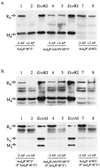Regulation of endonuclease activity by proteolysis prevents breakage of unmodified bacterial chromosomes by type I restriction enzymes
- PMID: 10449767
- PMCID: PMC22283
- DOI: 10.1073/pnas.96.17.9757
Regulation of endonuclease activity by proteolysis prevents breakage of unmodified bacterial chromosomes by type I restriction enzymes
Abstract
ClpXP-dependent proteolysis has been implicated in the delayed detection of restriction activity after the acquisition of the genes (hsdR, hsdM, and hsdS) that specify EcoKI and EcoAI, representatives of two families of type I restriction and modification (R-M) systems. Modification, once established, has been assumed to provide adequate protection against a resident restriction system. However, unmodified targets may be generated in the DNA of an hsd(+) bacterium as the result of replication errors or recombination-dependent repair. We show that ClpXP-dependent regulation of the endonuclease activity enables bacteria that acquire unmodified chromosomal target sequences to survive. In such bacteria, HsdR, the polypeptide of the R-M complex essential for restriction but not modification, is degraded in the presence of ClpXP. A mutation that blocks only the modification activity of EcoKI, leaving the cell with approximately 600 unmodified targets, is not lethal provided that ClpXP is present. Our data support a model in which the HsdR component of a type I restriction endonuclease becomes a substrate for proteolysis after the endonuclease has bound to unmodified target sequences, but before completion of the pathway that would result in DNA breakage.
Figures







References
-
- Redaschi N, Bickle T A. In: Escherichia coli and Salmonella: Cellular and Molecular Biology. Neidhardt F C, Curtiss R, Ingraham J L, Lin E C C, Low K B, Magasanik B, Reznikoff W S, Riley M, Schaechter M, Umbarger H E, editors. Washington, DC: Am. Soc. Microbiol.; 1996. pp. 773–781.
-
- Price C, Pripfl T, Bickle T A. Eur J Biochem. 1987;167:111–115. - PubMed
-
- Titheradge A J, Ternent D, Murray N E. Mol Microbiol. 1996;22:437–447. - PubMed
Publication types
MeSH terms
Substances
LinkOut - more resources
Full Text Sources
Molecular Biology Databases

